After an early flight from the southern Kazakhstan city of Shymkent where we'd been for the last several days, we returned to Almaty, the country's former capital, that we'd first visited for about six hours a month previously as a layover before our Kyrgyzstan horse trip. We weren't terribly enthralled with the snowy weather but had luckily decided to spend the afternoon indoors at the city's Central State Museum after relaxing at the guesthouse.
What a hardy soul enjoying the park on a snowy day!
The collection of gold items from the 8th century BC was remarkable.
What a hardy soul enjoying the park on a snowy day!
I had not been terribly enthused by what we'd seen previously in Almaty although the city's large Soviet-style sculptures had been very impressive.
I was surprised to see a large branch of the UN's World Health Organization in the city.
After a brisk 50 minute walk, we reached the museum with the typical Central Asian turquoise accent color that was reminiscent of the wonderful Timurid architecture found throughout the Silk Road cities of Uzbekistan and, to a lesser degree, also at the Yasui Mausoleum in Turkistan.
An unusual sculpture was on the front steps. It was too chilly for me to want to spend time examining it, however!
I was surprised to learn that the Museum was one of the biggest museums in Central Asia and that it began in the 1930s as a local museum only. The current building, which dated from 1985, had a collection of 300,000 artifacts.
A reproduction of the 4th century BC Golden Prince Warrior that was discovered near Almaty.
Pictures were allowed in the entrance hall but not in the exhibition rooms so I had to be very surreptitious taking these ones of the superb Ethnographic Gallery! I was 'safe' taking the photo of the well equipped yurt in the center as I took it from the doorway with my zoom lens.
The gallery was dedicated to Kazakh nomadic culture with traditional dresses, jewelry, carpets, musical instruments, kitchen utensils, weapons and saddles. I was only able to take a few pictures and those on the sly, though.
I wonder what Gillette would think of this old shaving knife!
This was described as a bed wall and curtain.
Shoved away in the corner was this almost forgotten snow leopard, an animal commonly found in much of Central Asia.
Friezes with no explanations:
Often thanks to Stalin and Soviet policies before Kazakhstan claimed its independence, many different minorities have inhabited Kazakhstan especially Germans, Greeks, Chechen, Tatars, Poles and Koreans. I think the country's multi-ethnic makeup was the background for this collection of colorful paintings.
Just as we'd just seen the day before at Turkistan's Ethnography Museum, there was again an exhibition on Modern Kazakhstan dedicated to Nursultan Nazarbayev, the country's first president, and the independent Kazakhstan But there was also quite a bit of information about Kazakhstan's important oil industry.
I also learned that the blue in the country's flag stood for tranquility and prosperity and the gold sun meant restfulness and wealth. The eagle in the flag symbolized "wisdom, vigilance and the high aspirations of the Kazakh people."
The national emblem was the shanyrak, the cross-hatched center at the top of a yurt, as it was the symbol of a paternal home. Historical traditions and motives were represented by mythical horses in the emblem.
There was a vast collection of gifts presented to Nazarbayev by foreign diplomats but also, intriguingly, by fellow Kazakhs in Russia and elsewhere.
A mother-of-pearl table decoration of the Al-Aqsa Mosque in Jerusalem was given by Yasser Arafat in 1999.
The display of Kazakh Olympic clothing was certainly the first time I had ever seen anything like that in any national museum!
The three custodians in the downstairs Paleontology and Archaeology Gallery didn't seem to care a whit about pictures being taken or pay any attention to us at all as they spent all their time chatting among themselves from what I observed. That made it a lot easier to take photos!
I thought the reconstruction of the man from the Neolithic period from western Kazakhstan must have taken many artistic liberties!
Stone arrowheads and flints also from the same period:
Stone disks and drills, etc:
Reconstruction of living quarters from the late Bronze Age:
Somehow, it was determined that burial in a stone chest like this was common in the Andronovo region of Kazakhstan from the 15th-12th centuries BC.
Rock paintings from the Bronze and Early Iron Ages:
A common sight throughout Almaty were representations of the 'Golden Man,' the attire of a 4th century BC Saka warrior found in a burial mound near the city.
Written sources and archaeological finds indicate that the majority of tribes who settled in the early Iron Age in what is now southern and eastern Kazakhstan entered into a Saka tribal union.
The collection of gold items from the 8th century BC was remarkable.
Ancient armourers prepared small sized bows and arrows for a thrusting and cutting motion which the Persians called Akinaks.
In Saka times, the middle of the first thousand years BC, there were already specialized types of production of mining and working of ore, blacksmithing and jewelry making. Ancient livestock farmers acquired and processed raw materials needed for the production of work tools, instruments, clothing and household utensils.
At the time of the early nomads, significant shifts took place in the social structure of the ancient community. Differences in property ownership grew, and tribal unions a century before Christ corresponded with the initial phase of the beginnings of statehood.
A treasure hoard of tiny gold pieces dating from the first century AD was found not far from Almaty.
The gravestone with the Turkic-Syrian inscription was from 1652 and spoke of a prayer at night remembering St. John the Baptist.
The model showed the mausoleum of Khoja Ahmed Yasui that we had just seen in Turkistan that was built by Timur's orders from 1396-1404 over the grave of the ancient Turkic poet and preacher of Islam.
The Central State Museum wasn't a 'winner' in our opinion but the ethnology and ancient history exhibits had been moderately interesting. In hindsight, we wouldn't have missed much if we'd given the museum a pass. Almost hidden behind the trees across from the Museum was the Presidential Palace.
Right beside the Presidential Palace was City Hall.
In the central square across from City Hall was an immense monument and atop it was another representation of the Golden Man.
The old car stuffed with pomegranates in a public square garnered lots of funny looks!
Another amusing sign for my bathroom sign collection, courtesy of Burger King!
Steven knew to pause when we saw this first as he was sure I'd want to take a picture of the snails by the entrance to the metro station. I just wondered if it was a commentary on the speed of the metro!
How many more copies of the Eiffel Tower will we see this trip, I wonder? I think this was the third one!
We must have passed a film school as there were about half a dozen lights with projectors aimed toward a building.
Next post: Visiting the much, much better Almaty Arts Museum and discovering a swanky side to the city!
Posted originally on November 14th, 2018, and then updated two days later also from Madrid, Spain.











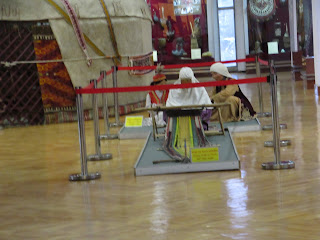






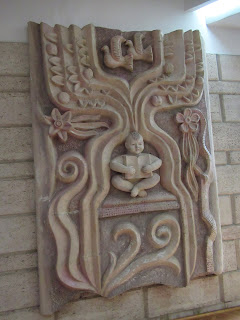





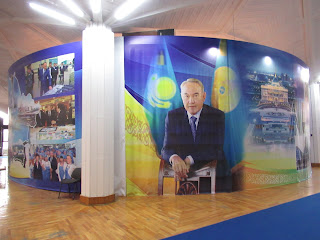



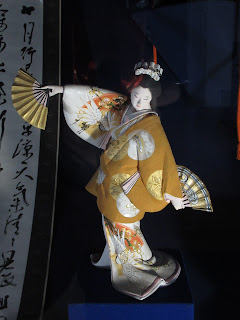





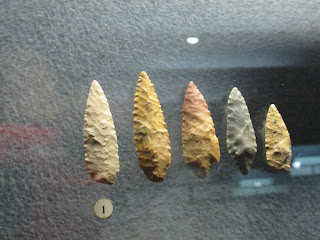













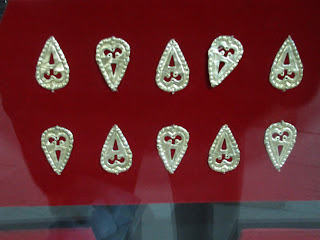
















No comments:
Post a Comment